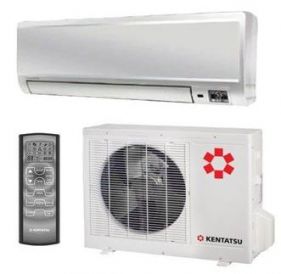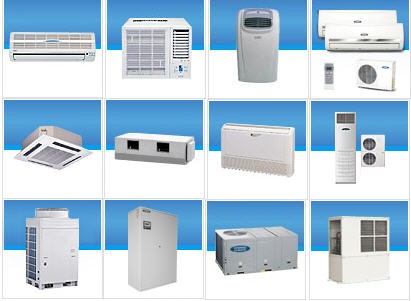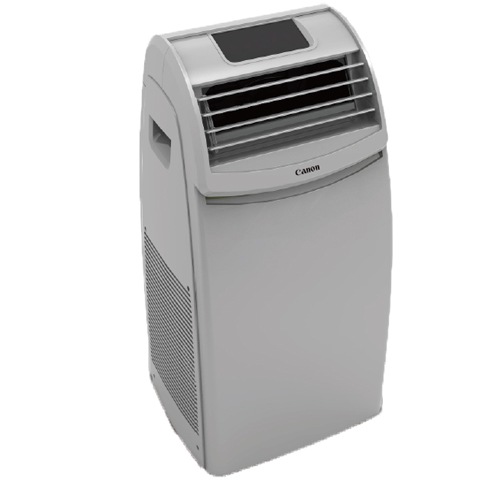Coming to the store of air conditioning equipment, the buyer, before making a purchase, often wonders how the split system differs from the air conditioner, and what does a better job with its tasks. To understand, it is worth understanding the features of both.
What is air conditioning and split system

Generally speaking, the word air conditioner is a generalized concept that is applicable to any cooling / heating equipment operating on a special substance - refrigerant (freon), and having main working units such as a compressor, a heat exchanger and a fan.
A split system is a type of air conditioner. Such a device has two units: outdoor or outdoor and indoor or indoor. In the first, the condensation of freon occurs, and in the second, its evaporation. The modules are connected to each other by electric wires and a copper pipeline - a freon line through which the working gas circulates.
In another way, the external module is called the condensing unit or abbreviated KKB, since it contains the main element of the external device - the compressor, which is responsible for pumping the required pressure to carry out the phase transition of the refrigerant. It also includes a condenser heat exchanger. This unit removes heat or cold from the system.
The internal unit is also called the evaporative unit, since there is an evaporative heat exchanger in which the freon goes into the liquid phase.
People are accustomed to the fact that air conditioners are often called monoblock devices: mobile and window devices, which contain all working elements in one case. Heat from mobile units is removed by a special corrugated hose (sleeve), which cuts into a window or ventilation system. At the window windows, it comes out due to the fact that the condenser heat exchanger is located outside.
Differences

So, we can conclude that there are still differences between the split system and the air conditioner. And what exactly?
It's easy to guess that the main difference is the design. The split system is divided into two units, and the air conditioner consists of one building.
The second difference follows from the first point - a different internal structure of the air conditioner and split system. In monoblock devices, the compressor, fan, heat exchangers and other additional elements are collected in one unit.
A split-system air conditioner has a different device. Noisy parts are taken out into the outdoor unit, namely the compressor, fan, condenser heat exchanger (it doesn’t make sounds, though). The room module contains an evaporator and a tangential fan that draws air from the room, as well as an electronic control board, a filtration system and other functional elements.
If we start from the device of split-system air conditioners and monoblock units, then you can find other differences, for example, the noise level. Two-piece units are quieter because the compressor and fan are outside the room.
More possibilities in split systems and in the distribution of processed air. The louvers can be directed horizontally, vertically and to the right / left, while many devices are equipped with automatic adjustment of the dampers with the ability to select the desired angle of inclination.Monoblock air conditioners have limitations in this.
Another important difference between a split system and an air conditioner is the complete set of additional functions and options. Various automatic modes, protective algorithms, multi-stage filtration system are the advantages of two-component devices.
Installation is also carried out in completely different ways. The window unit is cut into the glass unit, the mobile unit is installed on the floor and the air duct is brought out through the window or door. The owner himself can do this. A two-block system is installed by professional teams, since here you will need to connect the blocks with each other with a route and wires.
If you ask yourself which split system or air conditioner is better, then, undoubtedly, the first option will be the more profitable and convenient purchase. Quiet operation, convenient additional functions, space-saving placement, long service life - all this will be provided by a modern two-component system.
There is only one preponderance in the direction of monoblock air conditioners - they are better suited for heating a room than split systems, since for this they have a built-in heating element that works in any frost. Splits have restrictions on use during the cold season. They can only heat up at outdoor temperatures down to -5 ° C due to the lack of independent heating elements.
Types of split air conditioning systems
Mobile
In the world of climatic technology, there is another very interesting equipment for controlling the climate of a room - a mobile split system.
In fact, this is the same mobile air conditioner that can be moved around the room, but with an outdoor unit and a higher power - from 3 kW in the cold. True, only the compressor and the fan are placed in the external module, and warm air is still removed by the air duct from the indoor mobile unit. The route between the modules is flexible, and there is no drainage tube to drain the condensate. It is collected in a special tray, like conventional mobile air conditioners.
The noise problem has been solved, but its values, averaging 40-45 dB, still remain higher than that of full-fledged split systems.
Since in everyday life this type of split systems is not very convenient due to the listed features, their use is limited to installation in places of temporary residence: in rented apartments, in rented office premises, in summer cottages.
Classic

Classic split systems are also of several types, depending on the design of the indoor unit:
- wall-mounted;
- floor-ceiling or universal;
- columnar;
- cassette;
- channel.
In everyday life, wall-mounted air conditioners are more often used, since they have a lower power, which is quite enough for cooling and heating an ordinary room, and a simpler installation. The internal block of such a system is hung on the wall at a distance of 15-20 cm from the ceiling so as to cut off the influx of sunlight from the window. There should be no tall objects and no obstacles in front of him. It is advisable to direct air streams to an unused area of the room. They usually come from distribution grids on the lower part of the indoor unit housing and concentrate as much as possible at a distance of 1.5-2 m.
The external design of wall splits is very diverse - angular, vertical and standard rectangular models, made not only in white, but also in black, blue, red, silver and golden colors. As a rule, manufacturers determine their attention to improving this particular type of two-block units, since the maximum number of sales falls on their account.
Where more powerful systems are needed, universal devices are mounted that allow directing the jet along the wall or ceiling. Such air conditioners-split systems in the ceiling installation version provide the most uniform air distribution even in rooms with complex configurations.
Another big advantage of ceiling-type split-system air conditioners is the ability to solve the problem of cooling in rooms with panoramic glazing, where it is quite difficult to find a place to install the unit.
The power of some models reaches 15-16 kW for heat / cold.
These devices are mainly equipped with inverter control systems, due to which high energy efficiency and low noise values are achieved. Ease of use due to the double installation option (wall or ceiling), wide control possibilities and high-quality air purification in several stages complete the list of advantages of this type of climatic technology.

If ceiling split-system air conditioners are no longer different from wall-mounted air conditioners, then duct and cassette air conditioners have many differences. First of all, it is a hidden installation together with all communications in the suspended ceiling.
The cassette indoor unit is placed in a standard false ceiling panel, only the distribution grid is visible from the outside. Duct split systems can be removed both into false ceilings and false walls. But even among semi-industrial equipment, such devices stand apart, since these are very powerful air conditioners with flexible configuration, control and air supply not from the unit, but through the air ducts to the places where they are connected. Their power ranges from 2.5 to 36 kW.
It is the duct system that has the ability to supply fresh air to the room in 30-100% of the volume. Installation is complex and requires only a professional approach.
Column splits are characterized by high cooling capacity and automatic air flow distribution first to the ceiling space and then to the entire volume of the room.
Multi-split systems

A kind of combined units are air conditioners of multi-split systems, in which from 2 to 7 indoor units are connected to one outdoor unit. The installation of such equipment helps to solve the problem of cluttering the facade of the building and to provide cooling / heating of several rooms at the same time. Air conditioners of multi-split systems have more installation options due to the increased total length of the freon line and the height differences between the blocks.
In modern models, the total performance of all room units can exceed the rated cold power of the outdoor unit by 20-30%.
The only condition for using such equipment is to switch on simultaneously in all rooms only for cooling or only for heating.
There are multi-split systems in which it is possible to install air conditioners of different types as an indoor module: wall-mounted, universal, cassette, duct, column. Combine them depending on the characteristics of each refrigerated zone.
The minimum number of indoor units for a multi-split air conditioner is two. As a rule, in this version, the indoor modules are selected of the same type, more often they are wall-mounted devices, although installation of different types is also possible. They work simultaneously in only one mode, but otherwise there is no dependence between them, that is, you can set different temperatures or any other settings. Each module has a separate remote control.

Paying attention to the functionality of an air conditioner with two split systems and more, it is worth noting that there are no differences from a device with one indoor module. It is completed with:
- various fine filters;
- intelligent automatic temperature control;
- timer on / off;
- air flow control;
- functions such as restart and anti-icing of the KKB heat exchanger;
- protective shutdown in case of malfunctions;
- tracking sensors.
If we consider air conditioners with two split systems, then it is worth noting that manufacturers differ only in the technical characteristics of devices: power consumption, cooling and heating capacity, dimensions, route length, height differences, energy efficiency.
In most cases, a multi-split air conditioner is performed using inverter technology, since it provides more reliable compressor operation at a sufficiently intense load.
This equipment assumes installation during the repair, since it is better to lay the tracks to be laid in grooves in the wall than to mask them in decorative boxes along the walls. This is especially true if a multi-split air conditioner includes cassette and duct units, which, together with communications, require installation in a false ceiling or walls.
The installation of such a device does not fundamentally differ from the installation of a two-component system: the outdoor module is mounted on the wall, roof of the building or on the balcony, the indoor module is mounted indoors. This is the same stationary climatic equipment as the classic two-unit air conditioner.
There are inexpensive split-system air conditioners with a minimum set of additional functions and automation. These are produced not only by little-known companies, but also by world-famous manufacturers. These include the following trademarks:
- BALLU;
- DANTEX;
- GENERAL CLIMATE;
- GREE;
- HAIER;
- HYUNDAI;
- LG;
- MIDEA.
All these companies produce not too expensive split-system air conditioners, which can either be bought in a ready-made package, an outdoor unit + the required number of indoor units, or selected separately, based on personal needs.
How to make the right choice

How to choose the right air conditioner split system? What should you focus on?
Having decided on the type of indoor unit, the required refrigerating power of the device is calculated. On average, they take 1 kW per 10 m². If there is a lot of equipment in the room or sunlight enters it in excess, another 10-30% is added to this value.
When selecting equipment with several units, pay attention to the total power of all units and the ability of the outdoor module to support it.
Many do not know that when choosing a split-system air conditioner, you need to pay attention to the compressor, or rather, to the manufacturer. So called “no name” models can be of poor quality. The compressor breaks down, therefore, the outdoor unit loses its ability to function, which means that the entire system stops working.
In the passport of the climatic technology, they look at the permissible length of the route and the possible height difference, as well as whether the KKB compressor will be able to pump freon along it. This will be needed during installation.
It is worth familiarizing yourself with such technical characteristics as the minimum and maximum noise of both units, as well as the permissible outdoor temperature range at which the equipment can function.
If you need an inexpensive split-system air conditioner, then they look at the availability of additional functions. The fewer there are, the cheaper the technique.
Be sure to take into account when the air conditioner will be installed. If the repair has already been completed, then channel, cassette and multi-split systems cannot be installed.
These are the basic rules on how to choose split-system air conditioners for domestic or semi-industrial purposes.
Testimonials
Every year, reviews of split-system air conditioners are gaining more and more positive ratings. Users note that this climate technology:
- does not make noise;
- efficiently and evenly cools the air;
- perfectly warms the room in the off-season;
- gives good indicators for energy consumption;
- serves for a long time and rarely breaks;
- solves the problem of air conditioning in rooms of various configurations and sizes;
- saves space in the installed area.
Split-system air conditioners of unknown brands that use cheap plastic and not very high-quality components in the production of equipment receive negative reviews.
Poor installation can cause poor operation of an air conditioner even from a very well-known and expensive brand, so there is no point in saving on installation.








